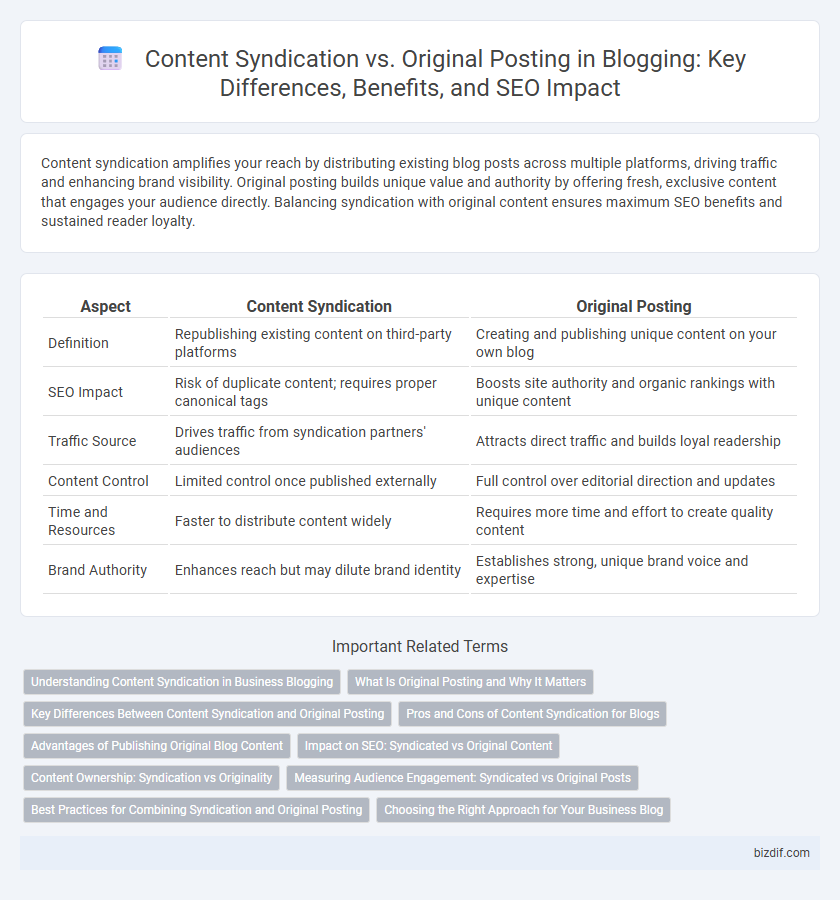Content syndication amplifies your reach by distributing existing blog posts across multiple platforms, driving traffic and enhancing brand visibility. Original posting builds unique value and authority by offering fresh, exclusive content that engages your audience directly. Balancing syndication with original content ensures maximum SEO benefits and sustained reader loyalty.
Table of Comparison
| Aspect | Content Syndication | Original Posting |
|---|---|---|
| Definition | Republishing existing content on third-party platforms | Creating and publishing unique content on your own blog |
| SEO Impact | Risk of duplicate content; requires proper canonical tags | Boosts site authority and organic rankings with unique content |
| Traffic Source | Drives traffic from syndication partners' audiences | Attracts direct traffic and builds loyal readership |
| Content Control | Limited control once published externally | Full control over editorial direction and updates |
| Time and Resources | Faster to distribute content widely | Requires more time and effort to create quality content |
| Brand Authority | Enhances reach but may dilute brand identity | Establishes strong, unique brand voice and expertise |
Understanding Content Syndication in Business Blogging
Content syndication in business blogging involves republishing existing articles on third-party platforms to expand reach and drive traffic back to the original site. This strategy enhances brand visibility and authority by exposing content to new audiences while maintaining SEO value through canonical tags. Unlike original posting, content syndication leverages established assets for broader distribution without the time investment of creating fresh material.
What Is Original Posting and Why It Matters
Original posting involves creating unique, unpublished content specifically for your blog, ensuring exclusivity and enhancing SEO rankings. It establishes your blog as a credible source, attracting organic traffic and building long-term audience trust. Search engines prioritize fresh, original content, which can improve visibility and reduce the risk of duplicate content penalties.
Key Differences Between Content Syndication and Original Posting
Content syndication involves republishing existing content on third-party platforms to reach a broader audience and boost SEO through backlinks, while original posting centers on creating unique, fresh content specifically for your own blog or website to establish authority and brand identity. Syndicated content often requires permission and careful attribution to avoid duplicate content penalties, whereas original content enhances search engine rankings by providing value and originality. Choosing between syndication and original posting depends on marketing goals, with syndication prioritizing distribution and original posting focusing on innovation and audience engagement.
Pros and Cons of Content Syndication for Blogs
Content syndication enhances blog reach by distributing articles across multiple platforms, increasing visibility and driving traffic back to the original site. However, it risks duplicate content issues that may harm SEO rankings if not managed with proper canonical tags. While syndication saves time and expands audience engagement, original posting offers unique content creation that strengthens brand authority and boosts search engine trust over time.
Advantages of Publishing Original Blog Content
Publishing original blog content enhances search engine visibility by providing unique, relevant keywords that improve SEO rankings. It establishes authority and trust with readers by offering fresh insights and authentic perspectives not found elsewhere. Original content also encourages higher engagement and social sharing, driving organic traffic and increasing brand recognition.
Impact on SEO: Syndicated vs Original Content
Original posting significantly enhances SEO by generating unique content that attracts backlinks and improves domain authority, fostering higher search engine rankings. Content syndication can increase visibility and drive traffic but risks duplicate content penalties if not properly managed with canonical tags or noindex directives. Prioritizing original content ensures long-term SEO benefits, while syndication should be strategically employed to complement and amplify the primary source without compromising search rankings.
Content Ownership: Syndication vs Originality
Content syndication allows bloggers to distribute their articles across multiple platforms, increasing reach but often sacrificing exclusive ownership and originality of the content. Original posting ensures full content ownership, preserving unique voice and SEO value for the creator's website. Maintaining originality boosts brand authority and search engine ranking, while syndicated content may face duplication penalties or diminished control over how the content is presented.
Measuring Audience Engagement: Syndicated vs Original Posts
Measuring audience engagement reveals that original posts typically generate higher interaction rates, including comments, shares, and time spent on page, compared to syndicated content. Syndicated posts often experience diluted engagement due to content repetition across multiple platforms, which can fragment audience attention. Analytics tools like Google Analytics and social media insights help track performance metrics, providing valuable data to optimize content strategy based on user behavior and engagement levels.
Best Practices for Combining Syndication and Original Posting
Combining content syndication with original posting enhances visibility while preserving SEO value by using canonical tags to attribute the original source. Prioritize syndicating high-quality, evergreen content to reputable platforms that reach your target audience without duplicating recent, time-sensitive posts. Maintain a consistent publishing schedule for original articles to build authority and use syndication strategically to amplify reach and drive traffic back to your primary blog.
Choosing the Right Approach for Your Business Blog
Content syndication allows businesses to expand their reach by republishing articles on multiple platforms, driving traffic and enhancing brand visibility. Original posting fosters unique content creation that improves SEO rankings, builds authentic audience engagement, and establishes authority in your niche. Evaluating factors like target audience, resource availability, and long-term goals helps determine whether syndicated content or original posts better support your blog's growth and marketing strategy.
Content Syndication vs Original Posting Infographic

 bizdif.com
bizdif.com